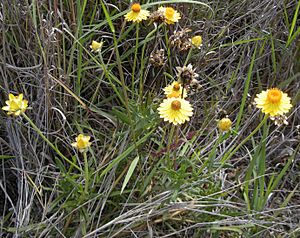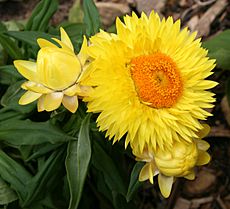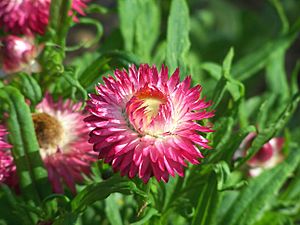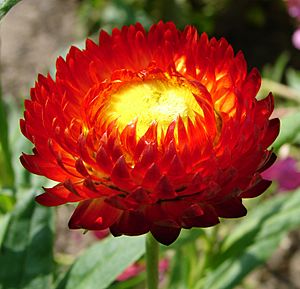Golden everlasting facts for kids
Quick facts for kids Golden everlasting |
|
|---|---|
 |
|
| Wild form of Xerochrysum bracteatum | |
| Scientific classification | |
| Kingdom: | |
| (unranked): | |
| (unranked): | |
| (unranked): | |
| Order: | |
| Family: | |
| Genus: | |
| Binomial name | |
| Xerochrysum bracteatum |
|

Xerochrysum bracteatum is a flowering plant in the daisy family Asteraceae and comes from Australia. In English, the plant is usually called golden everlasting or strawflower. It grows as a woody or leafy perennial or annual shrub. Depending on the type it can get up to a meter (3 ft) tall.
The golden everlasting serves as food for different kinds of larvae (caterpillars) of butterflies, moths and skippers. Adult butterflies, hoverflies, native bees, small beetles and grasshoppers visit the flower heads.
The golden everlasting is easy to grow. Annual varieties in a host of color forms are available.
Distribution and habitat
The Golden everlasting occurs in all Australian mainland states and territories as well as Tasmania. It is quite common and can be found from North Queensland across to Western Australia.
It occurs in all habitats except those that are in dense shade. It grows as an annual in patches of red sand in Central Australia, responding rapidly to bouts of rainfall to complete its life cycle. It is common among granite outcrops in southwest Western Australia, and is found on heavier and more fertile soils in the Sydney region, such as basalt-, shale- or limestone-based soils, generally in areas with a high water table. It has been reported growing in disturbed soil, along roadsides and in fields in the New England region in the United States.
Ecology
The brightly colored bracts act as petals to attract insects such as hoverflies, native bees and small beetles that pollinate the florets. Grasshoppers also visit the flower heads. The caterpillars of Tebenna micalis have been recorded on this species, as have those of the Australian painted lady (Vanessa kershawi). The tiny fruits are dispersed by wind, and germinate and grow after fire or on disturbed ground.
The water mould (oomycete) Bremia lactucae has infected commercial crops in Italy and California. In 2002 on the Ligurian coast, widespread infection of several varieties, most severely 'Florabella Pink' and to a lesser extent 'Florabella Gold' and 'Florabella White', resulted in leaf blistering and the development of lesions on the leaves, and white patches on the undersides, particularly in areas of poor ventilation. There was an outbreak of downy mildew in a crop of the Golden everlasting in San Mateo County, California in 2006, in which the leaves developed large chlorotic lesions. A Phytoplasma infection damaged X. bracteatum crops in the Czech Republic between 1994 and 2001, causing poor growth, bronzing of the leaves and malformation of flower heads. Genetically, the pathogen was indistinguishable from the agent of aster yellows. The root-knot nematode (Meloidogyne incognita) attacks and forms galls on the roots, which leads to the death of the plant.
Farming and breeding
The Golden everlasting had been introduced to farming in England by 1791. German horticulturist Herren Ebritsch obtained material and developed it at his nursery in Arnstadt near Erfurt in Germany. He bred and sold varieties of many colors from bronze to white to purple, which spread across Europe in the 1850s. The bracts of these early forms tended to remain cupped around the flower head rather than flatten out like the native Australian forms. These were also annual rather than perennial forms. Many were given names such as 'atrococcineum' (dark scarlet flower heads), 'atrosanguineum' (dark blood-red flower heads), 'aureum' (golden yellow flower heads), 'bicolor' (red-tipped yellow flower heads), 'compositum' (large multicolored flower heads), 'macranthum' (large rose-edged white flower heads), and 'monstrosum' (flower heads with many bracts), although today they are generally sold in mixed seed for growing as annuals. Some colored forms of South African Helichrysum are thought to have been introduced to the breeding program, which resulted in the huge array of colors. The Golden everlasting was one of several species that became popular with European royalty and nobility from the early 19th century, yet were little noticed in Australia until the 1860s, when they became more prominent in Australian gardens.
Most varieties started in Australia in the latter part of the 20th century are perennials. 'Dargan Hill Monarch' was the first of these, and many more have followed. Profusely flowering, these come in many colors including white, yellow, orange, bronze, pink and red. Their commercial lifespan is generally around three years. Queensland-based company Aussie Winners has a range of compact plants ranging from orange to white known as Sundaze. Plants of this series usually have larger leaves. This range won the Gran premio d'oro at the Euroflora exposition in Geneva in 2001, for the best new plant series in the previous three years. 'Florabella Gold', a member of the Florabella series, won the award for best new pot plant (vegetative) in the Society of American Florists' competition of 1999. The Wallaby variety of the flower range of taller forms with narrow leaves and white, yellow or pink flowers. Other commercial ranges include the Nullarbor series, and Queensland Federation daisies, including 'Wanetta Sunshine' and 'Golden Nuggets'.
The Golden everlasting are easy to grow both from seeds and from cuttings, although named varieties will only grow true from cuttings. Fresh seed germinates in 3 to 20 days and requires no special care. Plants grow best in acidic, well-aerated, soils of pH 5.5 to 6.3, with low levels of phosphorus. They are sensitive to iron deficiency, which shows on the plant as yellowing (chlorosis) of the youngest leaves while the leaf veins remain green.
The Golden everlasting can be grown in large pots or window boxes. It also makes a good starting plant in the garden before other plants become more established. Lower growing varieties are suitable for hanging baskets and border plantings. The flowers attract butterflies to the garden. Dried flowers are long lasting—up to some years—and are used in floral arrangements and the cut flower industry. More robust longer stemmed forms are used for commercial cut flowers. The main factor limiting lifespan of dried flowers is the wilting of stems, so flowers are sometimes wired into arrangements. Immersing flowers in glycerol or polyethylene glycol also lengthens lifespan.
Images for kids
See also
 In Spanish: Xerochrysum bracteatum para niños
In Spanish: Xerochrysum bracteatum para niños






